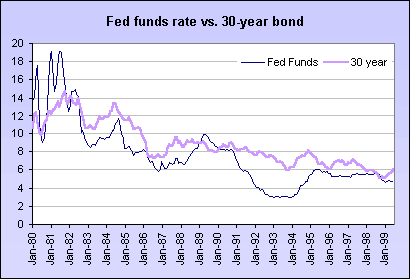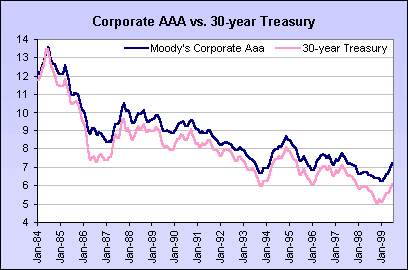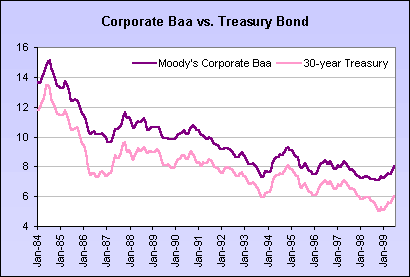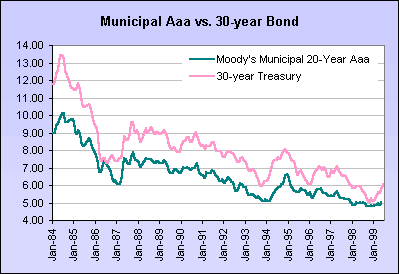Interest rates rising; spreads widening
Comparing fixed income securities
Evelina M. Tainer, Chief Economist

| Changes in Interest Rates since the low | |||
|---|---|---|---|
| Treasury Securities | June-99 | Oct-98 | Change |
| 3-month | 4.72 | 4.07 | 0.65 |
| 6-month | 5.03 | 4.20 | 0.83 |
| 1-year | 5.10 | 4.12 | 0.98 |
| 2-year | 5.62 | 4.09 | 1.53 |
| 5-year | 5.81 | 4.18 | 1.63 |
| 10-year | 5.90 | 4.53 | 1.37 |
| 30-year | 6.04 | 5.01 | 1.03 |
Interest rate predictions for year-end
Barron's compiles a survey of forecasts by roughly 25 economists at mid-year and at year-end to get their views on the federal funds rate target and the 30-year Treasury bond. The July 5th survey shows that most economists are predicting that the Fed will raise the federal funds rate target at least one more time before year-end. That is, sixteen of the 26 economists are looking for a fed funds target of 5.25 percent on December 31. Three economists expect two more rate hikes by year-end - with a funds rate target of 5.50 percent. Six economists believe that the June 30 rate hike was the only one for the year. One economist expects the Fed to reduce the fed funds rate to 4.50 percent. For a forecast that looks ahead six months, the range in this survey is not particularly wide.
The survey becomes more interesting when one compares the forecasts for the 30-year long bond yield. The average of the 26 economists amounts to 5.75 percent with a range of 4.50 to 6.37 percent. Yet, the bulk of the forecasts are higher than the average. The median estimate (the mid-point of the 26 forecasts) stands at 5.85 percent, which suggests that a few outliers with forecasts well below 5 percent are causing a mis-representation of the forecast survey. A minority anticipates that Y2K disruptions will cause investors to demand Treasury securities as a flight to quality adjustment. As a result, bond yields are expected to drop sharply from current levels.
What normally happens with Fed tightening
The Fed can't control all interest rates. It generally has the ability to affect bank reserves. The supply and demand for bank reserves determines the federal funds rate. So when the Fed is tightening credit conditions, it is basically limiting the supply of reserves in the banking system. Nevertheless, Fed policy tends to impact the level of interest rates in a broad sense. So when the Fed does raise the federal funds rate, most of the time, you will find that interest rates are higher in short, intermediate and long term securities. The chart below compares the level of the fed funds rate along with the yield on the 30-year bond. The two series don't exactly move in tandem in all cases, but the trend shows the increases and decreases occur at roughly the same time.

Treasury securities as benchmark to other fixed income markets
If the Barron's panel of forecasters is correct, then the Fed is likely to raise the federal funds rate at least one more time between now and the end of the year. Typically, that will lead to a hike in the general level of interest rates from the 3-month bill to the 30-year bond. If yields on Treasury securities are rising, it is likely that the yields on corporate and municipal bonds will rise as well since the Treasuries are the benchmark.

The chart above compares investment grade corporate bonds to the 30-year Treasury. The spread widened marginally throughout 1998 and remains wider than average in the past few months. Usually, the spread reflects differences in liquidity and credit quality. Triple A corporate bonds are considered good investments. During economic expansions the spread will narrow because the risk of default here is quite small. When credit conditions tighten, and economic conditions worsen, then the spread will widen because the risk of default for corporate bonds increases.
In the second half of 1998, the spreads widened not so much because U.S. corporations saw a drop in their credit quality, but the flight to quality from investors across the globe caused a sharp jump in demand for Treasury securities. The surge in demand raised the price of these securities - and lowered their yield.
If it is true that investors across the globe will fear some Y2K disruptions, then the demand for U.S. Treasury securities could lead to a sharp drop in their yield. This will cause the spread between the Triple A corporate bond and the 30-year Treasury bond to widen even if credit quality here hasn't suffered. For those investors who typically hold their bonds to maturity and are looking to get a higher yield, Triple A corporate bonds could be a good investment alternative.

The spread between the Baa corporate issue and the 30-year long bond is quite a bit wider. These lower-rated corporate bonds may have greater risk attached to them with respect to lower liquidity in times of credit crunch - and higher risk of default if economic conditions worsen. These will get you a higher yield - but at a cost. Realize that the higher yield on these lower rated bonds might not be sufficient for their creditworthiness, although some investors may be willing to take the risk.

Hindsight is always 20-20! The spread between Triple A municipal bonds and the 30-year long bond was virtually nil at the end of last year. This was totally due to the demand for Treasury securities, as investors around the globe fled to these risk-free securities. At the time, the yield on the municipals appeared to be quite favorable. Currently, the spread to the Treasury market is more in line with normal conditions. However, a flight-to-quality in Treasury yields that would induce lower rates in these instruments might once again point to a bargain in the municipal market.
THE BOTTOM LINE FOR INVESTORS
Rising interest rates are always viewed as "bad" in the United States. Perhaps it's because so many consumers borrow money to finance not only their homes and cars, but also their vacations and clothing and toys. Higher rates mean higher borrowing costs.
Businesses don't favor higher rates either - for the same reason. Investment projects need to meet higher standards (and rates of return) in order for borrowing at higher rates to be profitable.
There is a segment of the population that benefits from higher rates. These are lenders who would like to earn a fixed income at a lower risk than is attached to the stock market. Even investment professionals who extol the virtues of stocks will recommend some bonds in your portfolio. The best time to buy bonds is when rates are rising, because the interest payment (which is earned twice a year) will be higher.
Liquidity and credit quality are two determinants of the interest earned on a bond. The most risk-averse investors will find piece of mind by owning Treasury securities. Investors who are willing to take on some additional risk could buy corporate bonds with varying credit ratings.